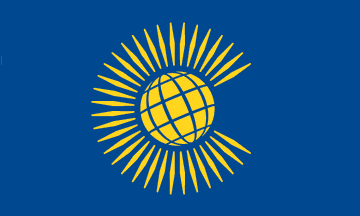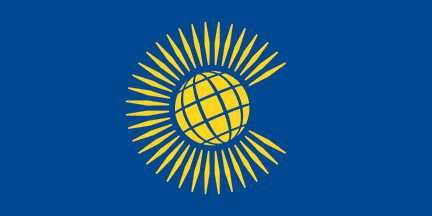 zachary harden
zachary harden
Keywords: british empire | commonwealth of nations | commonwealth games | international organization |
Links: FOTW homepage | search | disclaimer and copyright | write us | mirrors

Last modified: 2023-06-10 by  zachary harden
zachary harden
Keywords: british empire | commonwealth of nations | commonwealth games | international organization |
Links: FOTW homepage |
search |
disclaimer and copyright |
write us |
mirrors
 3:5
3:5
The standard shape
image by Rob Raeside, 12 November 2013
 1:2
1:2
For use in countries with 1:2 national flags
image by Rob Raeside, 12 November 2013
See also:
Other Sites:
There is a pdf sheet showing the
redesigned flag for the Commonwealth of Nations flag. The number of 'spearheads'
has been reduced from 64 to 34, the globe is slightly altered to make it
more 'dynamic', and the field colour is now Pantone 280, rather than 286.
The device is slightly offset to the hoist. The flag is produced in two
formats; the size to be used depends on the usual format within that
country. The design was changed at the request of the Commonwealth
Secretariat; it was adopted at the beginning of October this year.
Ian Sumner, 12 November 2013
3:5 version - the standard shape. The centreline of the emblem, the point
midway between the two top spearheads, is offset towards the hoist by 1% of the
flag width.
1:2 version - for use in countries with I x2 national flags. The centreline of
the emblem, the point midway between the two top spearheads, is offset towards
the hoist by I% of the flag width.
Colours used: Pantone 280 Pantone 116 The sheet published by The Flag
Institute, 7 October 2013
Rob Raeside, 12 November 2013

The flag was adopted on 26 March 1976 (source: Flagmaster, number
81, 1995).
Mark Sensen, 27 July 1996
The Commonwealth Secretariat web site includes some interesting information on the history of their flag, which it dates to 1973 but, as often understandably seems to be the case with official sources, there is no earlier symbol or flag for comparison purposes:
The Commonwealth symbol was originally designed by the Gemini News Service, London in 1972 and approved by the first Commonwealth Secretary-General, Mr Arnold Smith C.H.
In 1989 a second logo was introduced to appear on official Commonwealth Secretariat publications, and in 1999 a special commemorative logo was produced to mark the 50th Anniversary of the modern Commonwealth.
In 2000 the current Secretary-General Rt. Hon Don McKinnon, approved a new design that is now in use in place of the original designs. This design incorporates the image of the globe used in the original logo and the spears that make up the letter "C" from the 1989 design.
The radiating spears do not represent the number of countries in the Commonwealth but symbolise the many facets of Commonwealth cooperation around the world. The symbol is used on all official documentation and, sometimes in association with other specially developed logos, for the documents and logos of all Commonwealth Meetings. There is no fixed size or colour for the symbol but because of its frequent appearance on Commonwealth documentation, the black on white and gold on blue versions are commonly used.
The Commonwealth Flag consists of the Commonwealth symbol in gold on a blue background centred on a rectangle.
The flag developed from the car pennants produced for the first time at the Ottawa Commonwealth Heads of Government Meeting in 1973.
It is flown at Marlborough House, London, the headquarters of the Commonwealth Secretariat, throughout the year and for a limited period at other venues where Commonwealth Meetings are held or when other Commonwealth events/ visits are taking place for example Commonwealth Heads of Government Meetings.
The flag shown on the
Commonwealth Secretariat web site uses a lighter blue and spindle-shaped
spears.
Colin Dobson, 14 July 2005
Just a small bit of info I found. According to the Department of Canadian
Heritage, the colors used on this flag is Pantone 287 for blue and Pantone 108
for yellow.
Source:
http://www.pch.gc.ca/pgm/ceem-cced/etiqtt/104-eng.cfm#a3)
Also, when I looked up the design of the Commonwealth emblem, the spheres that
are supposed to encirlce the globe are more like diamonds, like at
here. Color information, and using the logo came from page 3 of this
document.
Zachary Harden, 30 March 2010
The members are Antigua and Barbuda,
Australia, the Bahamas, Bangladesh, Barbados, Belize, Botswana, Brunei, Cameroon, Canada, Cyprus, Dominica, Fiji (suspended), Gabon, the Gambia, Ghana, Grenada, Guyana, India, Jamaica, Kenya, Kiribati, Lesotho, Malawi, Malaysia, Maldives, Malta, Mauritius, Mozambique, Namibia, Nauru (special member),
New Zealand, Nigeria,
Pakistan, Papua New Guinea,
Rwanda, St.Kitts and Nevis, St.Lucia, St.Vincent, Samoa, Seychelles, Sierra Leone, Singapore, Solomon Islands, South Africa, Sri Lanka, Swaziland, Tanzania, Tonga, Trinidad and Tobago, Togo, Tuvalu, Uganda, United Kingdom,
Vanuatu, Zambia, Zimbabwe (suspended).
based on
https://thecommonwealth.org/our-member-countries, 28 December 2006
and subsequent updates.
It may be of interest to you that the pre-1972 Northern Ireland flag, though
no longer used by the Government there, was used officially at the recent
Commonwealth Games in Glasgow, being carried in procession before the Northern
Ireland team, and hoisted at appropriate medal ceremonies.
Kenneth Fraser, 05 August 2014
The Commonwealth of Nations is listed on the Guinness Book of Records as
the World's largest political alliance.
The Commonwealth of Nations is an evolving entity from the old British
Empire. While some regard the Commonwealth as an anachronism, the ties to
"the old country" has kept the movement going, as shown by the Commonwealth
Games, which are held every four years. Mozambique was the first non-former-British
Empire nation admitted to the alliance in the last decade of the 20th century.
At 15:21 21/04/2003 -0000, J. Patrick Fischer wrote: In flags@yahoogroups.com,
Nathan Lamm wrote: Are there any other members of the Commonwealth that were
not British colonies at some point? On the other hand, what nations that
were British colonies are not? I can think of the US, Ireland, and Arab nations
(and mandates like Israel), as well as pre-modern period possesions in France,
Central America, and so on.
Santiago Dotor replied: Namibia (1884-1920: German Protectorat, 1920-1990:
South African Protectorat).
Sorry for the rather NFR nitpicking but am I wrong in believing that South
West Africa (SWA) was a League of Nations, later UN, *mandate* (not quite
the same as a protectorate) from 1920 to 1966, and after that an occupied
territory?
Dean Thomas replied: South Africa wanted to incorporate SWA into it's territory after World War 2, but the United Nations did not want this to happen. South Africa did not want SWA placed under the UN trusteeship system so it said that the territory would continue to be administered under the original League of Nations Mandate. The UN declared an end to the mandate in 1966 - which south Africa ignored until 1990.
At 17:27 21/04/2003 +0100, Jorge Candeias wrote: Part of Cameroon,
too, was never under British control.
Santiago Dotor replied: I believe that actually all of nowadays Cameroon
was under British control, although only part of the German protectorate
of Cameroon(s) became British Cameroon -- the rest going to French Central
Africa (Ubangi-Chari) and Gabon. See Joaquín de Salas excellent map
of colonial Africa 1912: http://www.terra.es/personal7/jqvaraderey/191206af.gif.
Dean Thomas, 31 March 2004